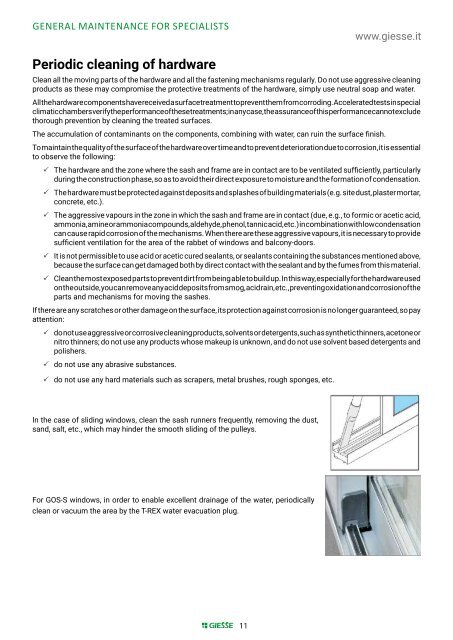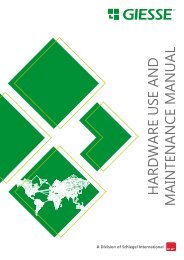GIESSE_Use and Maintenance Manual_EN_web
Create successful ePaper yourself
Turn your PDF publications into a flip-book with our unique Google optimized e-Paper software.
G<strong>EN</strong>ERAL MAINT<strong>EN</strong>ANCE FOR SPECIALISTS<br />
www.giesse.it<br />
Periodic cleaning of hardware<br />
Clean all the moving parts of the hardware <strong>and</strong> all the fastening mechanisms regularly. Do not use aggressive cleaning<br />
products as these may compromise the protective treatments of the hardware, simply use neutral soap <strong>and</strong> water.<br />
All the hardware components have received a surface treatment to prevent them from corroding. Accelerated tests in special<br />
climatic chambers verify the performance of these treatments; in any case, the assurance of this performance cannot exclude<br />
thorough prevention by cleaning the treated surfaces.<br />
The accumulation of contaminants on the components, combining with water, can ruin the surface finish.<br />
To maintain the quality of the surface of the hardware over time <strong>and</strong> to prevent deterioration due to corrosion, it is essential<br />
to observe the following:<br />
33<br />
The hardware <strong>and</strong> the zone where the sash <strong>and</strong> frame are in contact are to be ventilated sufficiently, particularly<br />
during the construction phase, so as to avoid their direct exposure to moisture <strong>and</strong> the formation of condensation.<br />
33<br />
The hardware must be protected against deposits <strong>and</strong> splashes of building materials (e.g. site dust, plaster mortar,<br />
concrete, etc.).<br />
33<br />
The aggressive vapours in the zone in which the sash <strong>and</strong> frame are in contact (due, e.g., to formic or acetic acid,<br />
ammonia, amine or ammonia compounds, aldehyde, phenol, tannic acid, etc.) in combination with low condensation<br />
can cause rapid corrosion of the mechanisms. When there are these aggressive vapours, it is necessary to provide<br />
sufficient ventilation for the area of the rabbet of windows <strong>and</strong> balcony-doors.<br />
33<br />
It is not permissible to use acid or acetic cured sealants, or sealants containing the substances mentioned above,<br />
because the surface can get damaged both by direct contact with the sealant <strong>and</strong> by the fumes from this material.<br />
33<br />
Clean the most exposed parts to prevent dirt from being able to build up. In this way, especially for the hardware used<br />
on the outside, you can remove any acid deposits from smog, acid rain, etc., preventing oxidation <strong>and</strong> corrosion of the<br />
parts <strong>and</strong> mechanisms for moving the sashes.<br />
If there are any scratches or other damage on the surface, its protection against corrosion is no longer guaranteed, so pay<br />
attention:<br />
33<br />
do not use aggressive or corrosive cleaning products, solvents or detergents, such as synthetic thinners, acetone or<br />
nitro thinners; do not use any products whose makeup is unknown, <strong>and</strong> do not use solvent based detergents <strong>and</strong><br />
polishers.<br />
33<br />
do not use any abrasive substances.<br />
33<br />
do not use any hard materials such as scrapers, metal brushes, rough sponges, etc.<br />
In the case of sliding windows, clean the sash runners frequently, removing the dust,<br />
s<strong>and</strong>, salt, etc., which may hinder the smooth sliding of the pulleys.<br />
For GOS-S windows, in order to enable excellent drainage of the water, periodically<br />
clean or vacuum the area by the T-REX water evacuation plug.<br />
11




